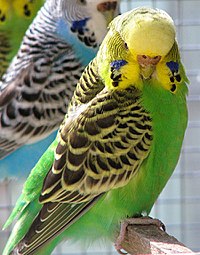
Photo from wikipedia
Under light-limiting conditions, many ornamental greenhouse-grown plants show undesired morphological characteristics, such as plant elongation (hypocotyl and epicotyl length) and low dry mass, which reduce plant quality. Research has shown… Click to show full abstract
Under light-limiting conditions, many ornamental greenhouse-grown plants show undesired morphological characteristics, such as plant elongation (hypocotyl and epicotyl length) and low dry mass, which reduce plant quality. Research has shown that use of plant growth regulators (PGRs) and changes in both light intensity and spectral composition can reduce these undesired characteristics. However, little is known about the role of the combined effects of supplemental lighting and PGRs on the production of ornamental seedlings. The objective of this study was to characterize the combined and independent effects of light intensity, spectral composition, and PGR applications on the greenhouse production of ornamental transplants. Petunia (Petunia × hybrida), geranium (Pelargonium × hortorum), pansy (Viola × wittrockiana) and dianthus (Dianthus chinensis) were grown for 32–42 days under three supplemental light (SL) treatments: 1) high-pressure sodium (HPS), 2) light-emitting diodes (LEDs) with a 6 blue (B):5 green (G):89 red (R) (percent photon flux ratio), and 3) LEDs with 19B:81R (100 μmol m−2 s−1, 18 h photoperiod for all treatments). A control (No SL) was also included. In addition, a portion of plants were also sprayed with the paclobutrazol PGR (PBZ and No PBZ). The synergistic effects of the combination of PBZ and supplemental lighting resulted in the most compact plants, caused by a reduction in plant height by PBZ and an increase in dry mass by SL. However, PBZ reduced shoot dry mass of most plant species and light combinations. Plant compactness was greater under the 6B:5G:89R LED composition for petunia and when combined with PBZ for geranium than for plants under HPS lighting. Root dry mass of petunia, geranium, and pansy plants increased in response to SL compared with no SL by 2.4–5.7-fold. Results from the two LED spectra were unexpected; plants under 6B:5G:89R were more compact (petunia, geranium), had higher anthocyanin concentrations (petunia), were shorter (petunia, pansy, dianthus) and had less leaf area (petunia, pansy, dianthus) than plants in the SL treatment with a higher B and lower G PF (19B:81R). Supplemental lighting and PBZ can be used in conjunction or independently to improve plant morphology. The increased light from SL provided the most benefits by improving dry mass, compactness, and leaf number for most plant species. However, when PBZ was used in combination with SL, plant compactness increased for some species. The spectral composition of SL had an impact on plant growth and morphology, warranting additional research on plant responses to small changes in the spectral composition of SL.
Journal Title: Journal of Plant Growth Regulation
Year Published: 2021
Link to full text (if available)
Share on Social Media: Sign Up to like & get
recommendations!